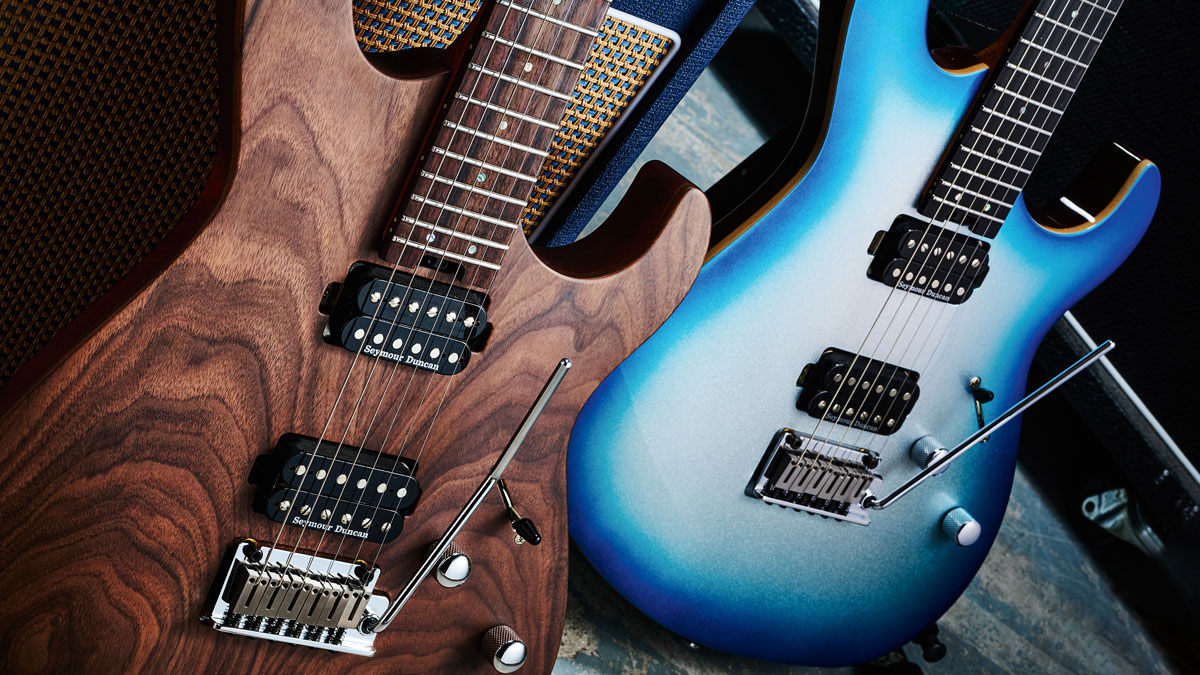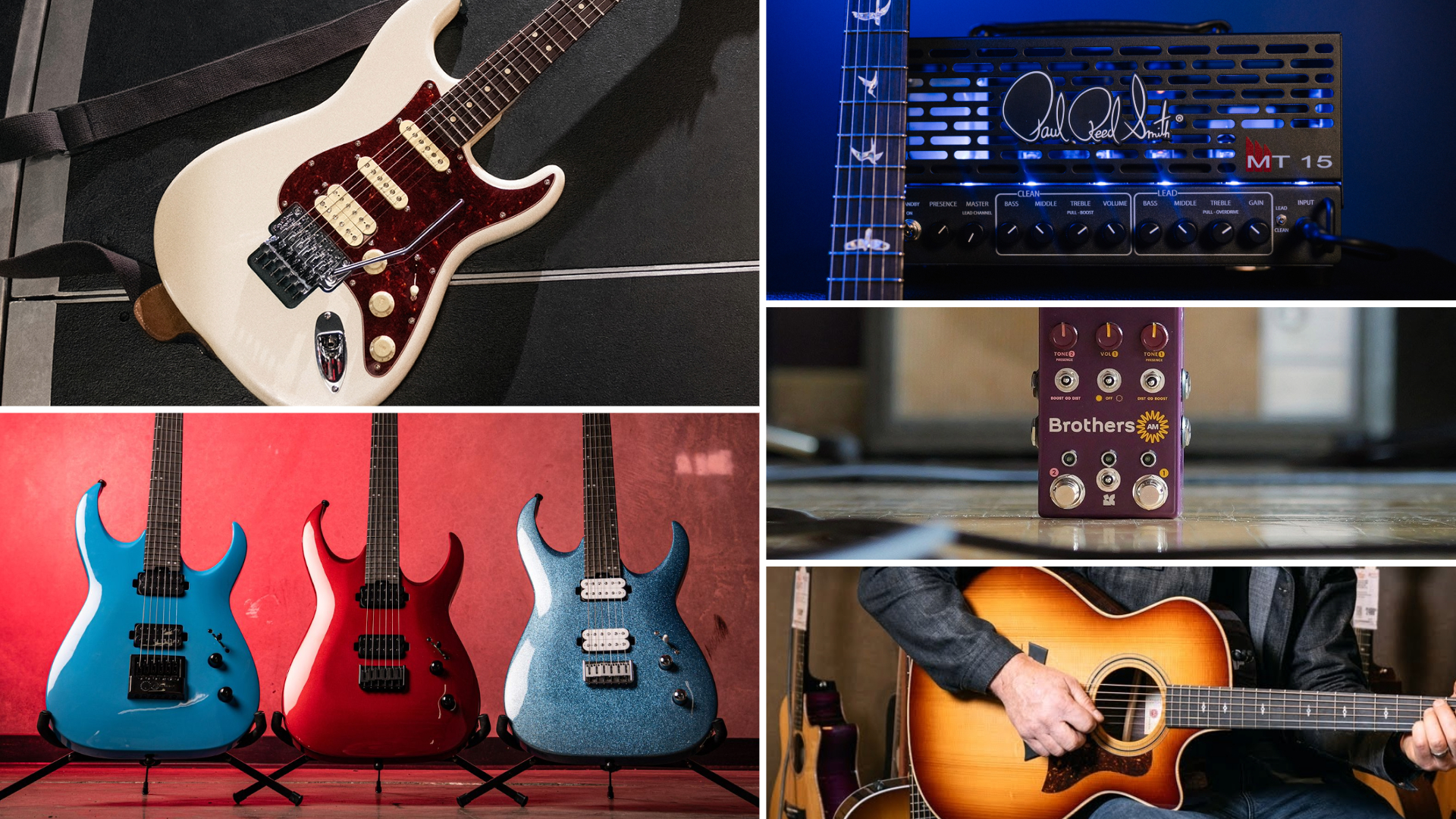Guitar World Verdict
With pickup designs that date back to the early ’70s, this is a pair of big-sounding, versatile instruments that are big on quality and slim on your wallet. Very hard to argue with.
Pros
- +
Crisp, contemporary design and build.
- +
Chambered body.
- +
Graphite reinforced neck.
- +
Stainless-steel frets
- +
Classic Seymour Duncans.
- +
Simply great guitars that cover a very wide range of sounds and styles.
Cons
- -
No color options.
- -
No gigbag.
You can trust Guitar World
It’s becoming a bit of a cliché to say that the quality of electric guitars made in Asia just keeps getting better and better. But the proof is in the instruments themselves.
When we looked at Cort’s G300 Pro, we concluded that it was “a difficult guitar to fault, the sort of instrument that spans pretty much every rock genre there is and quite a bit more… a real everyman instrument that could sit in a modern metal band just as easily as a function pop/soul ensemble.”
Not bad since it’s currently priced at $699/£749 – and comes in a rather fetching Metallic Gold for this year. And now it’s joined by an additional pair of G300s: the Glam and Raw. Slightly odd names, perhaps, but both rather accurately describe what’s on offer.
Although the new models replicate the original in the majority of features, it’s the wood choice that differs. Both our G300s feature a body that uses chambered African mahogany. The Glam’s 6mm top is maple, although the only wood you can see is on the very clean, PRS-inspired natural edge ‘binding’ as the rest is colour-coated in a rather polarising but very well done Polar Ice Metallic Burst.
The gloss of the front is continued over the rest of the body, which is left natural (with a stain to enhance the rich brown of the mahogany) and you can clearly see it’s a three-piece spread. By tapping your nails over the body you can also ‘hear’ the chambering, which seems to be primarily on the bass side under the dropped maple top over a generous forearm contour.
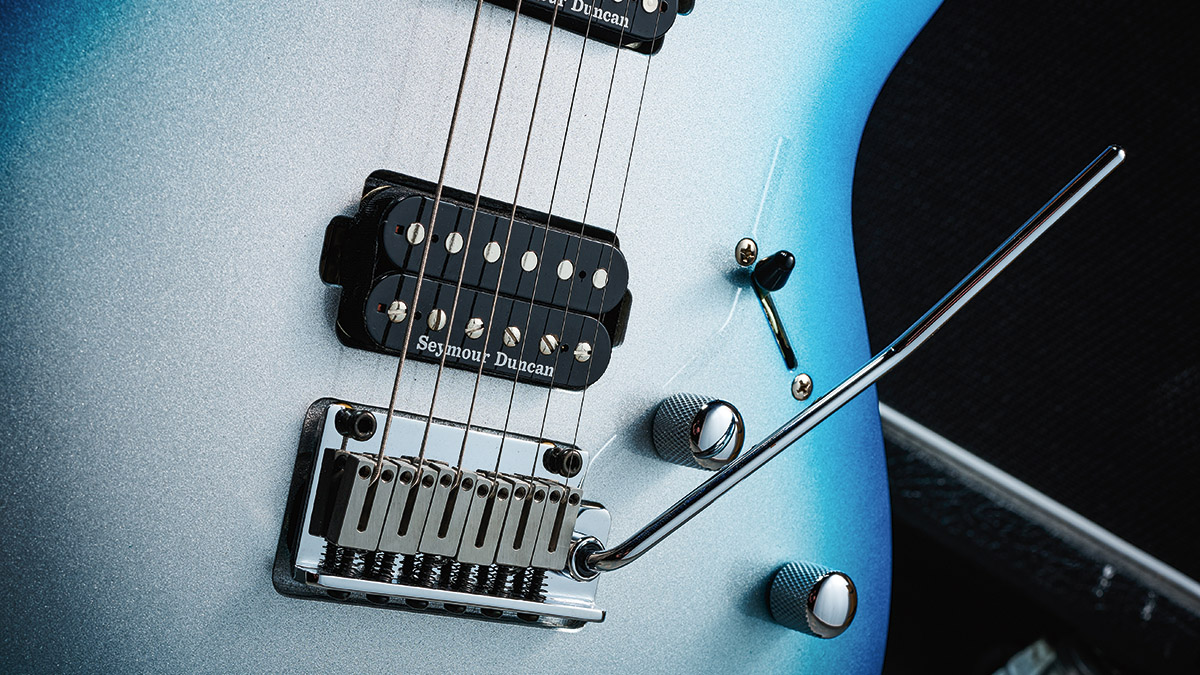
The Raw follows the same construction, but aside from the all-over thin satin finish the top here is a moody and quite vividly figured solid walnut that’s centre-joined and almost seems bookmatched. Like the Glam, the overall body depth is the bolt-on standard of 45mm.
The other major change to both these guitars is the necks, where the trendy roasted maple of the standard G300 Pro is replaced with the more unusual (for a bolt on) mahogany. Both are one-piece and appear to be quarter-sawn.
As used by Charvel, for example, you’ll find a pair of reinforcing graphite rods either side of the two-way truss rod, which has the convenient spoke-wheel adjustment just in front of the 24th fret.
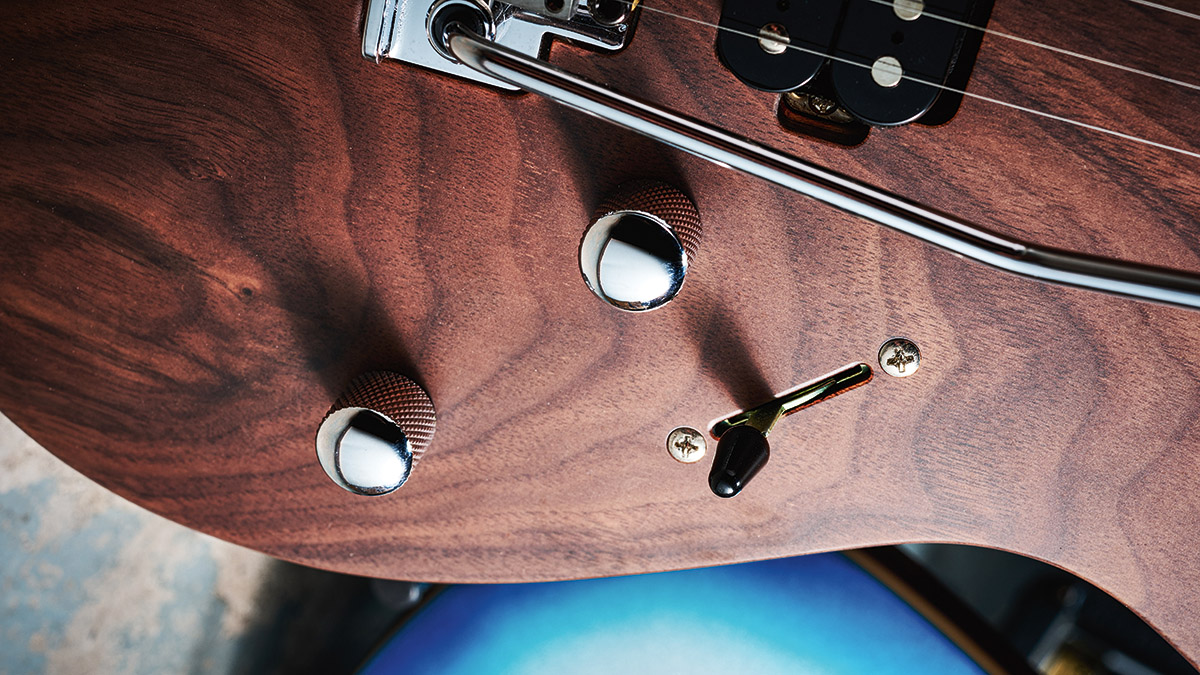
Though the Raw’s mahogany is actually darker with a vivid striped grain, here it’s left a more natural, lighter brown in colour compared with the stained body backs and is simply held via four screws in recessed cup washers on the lightly chamfered and contoured heel.
Another subtle difference is the fingerboard, which is a jet-black ebony on our Glam and a dark rosewood on the Raw. Both have a compound radius and feature 24 well-fitted and fettled stainless steel-frets.
Now, combine this craft with the classic Seymour Duncan pickup array and some clever wiring from the five-way lever switch, as well as a very well-engineered vibrato (with a back rout), rear-locking tuners and a Graph Tech nut, and we’re already double-checking the prices we’ve been given. If there’s a catch we haven’t found it yet – though we should mention that neither comes with a gigbag.
Feel & Sounds
Despite the mainly mahogany build, both guitars are light and very comfortable. While the outline shape might be a bit too generic ‘modern super-S’ for some, it’s very ergonomically aimed and hangs really well on a strap – but it could just as easily be a comfortable sofa-noodler. There might be a strong whiff of ‘contemporary modern’ in the style but not in the actual neck shape.
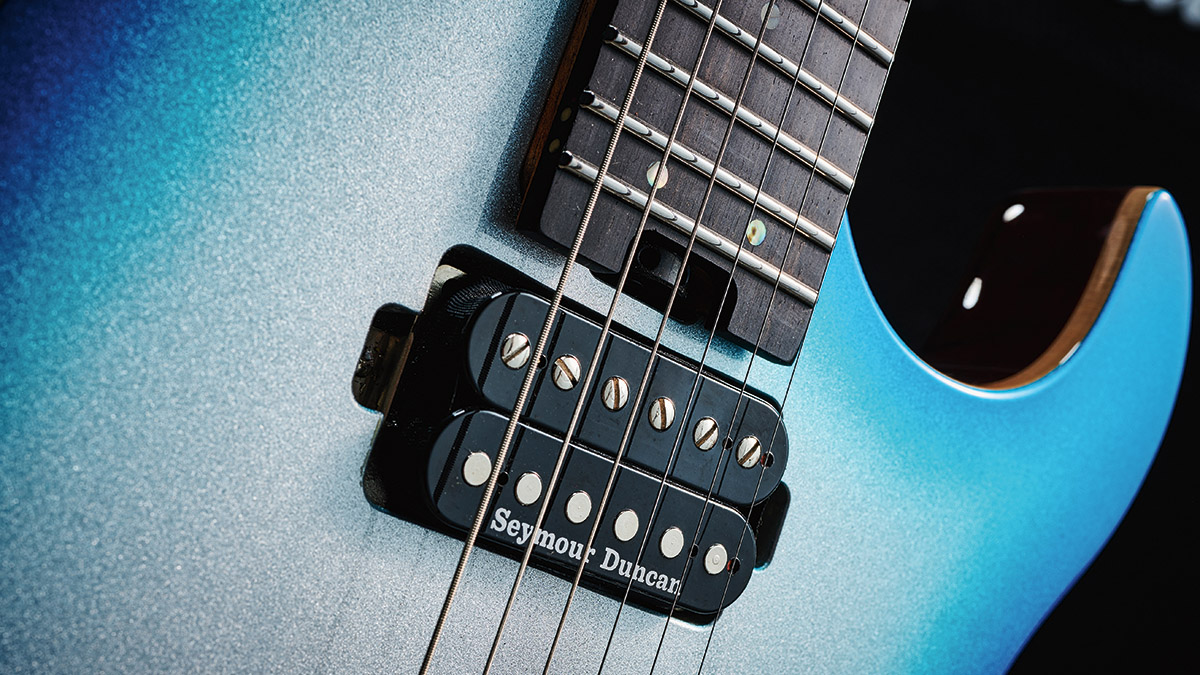
These are Fender width (42mm or just under at the nut and 52mm by the 12th) with a pretty full-shouldered C profile that measures 21mm at the 1st fret and 23mm by the 12th on the Glam, while the Raw is about 0.5mm deeper.
There’s certainly quite a contemporary compound radius to the fingerboard, which starts at 305mm (12 inches) at the nut and flattens out to 400mm (15.75 inches) by the 24th.
A little more edge rounding to the fingerboard and the fret ends wouldn’t go amiss, but it’s hard to fault the fretting, with its medium jumbo-sized stainless-steel wire that measures approximately 2.7mm wide and around 1.45mm high. All in, both are very good players, particularly with that almost bare wood feel to the silky satin neck finish – it reminds us of older necks that have been refretted.
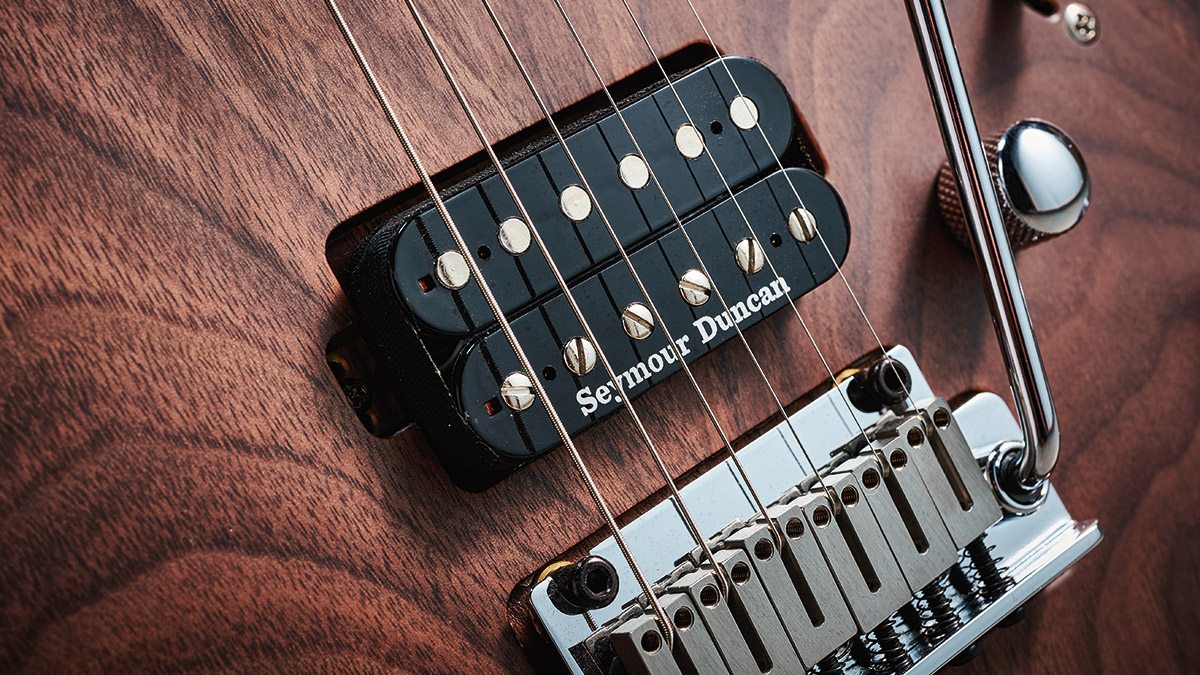
One very impressive feature is the vibrato. The all-steel unit is based on Gotoh’s 510 design. With its tension-adjustable push-fit arm and in combination with the slippery nut and locking tuners, it’s very stable with down-bend to slack and up-bend of a minor 3rd on the G string, thanks to that back rout. Another big tick on the already impressive feature list.
Sonically, these guitars are quite the proposition. Anyone who works at the gainier end of classic rock and beyond will be at home with the JB at the bridge, which kicks hard with a huge dollop of honky thick midrange. Yet pull the gain back to use it cleaner and it’s surprisingly smooth.
The Jazz is a good foil, a PAF-style known for its added clarity, but on these G300s it simply sounds very nicely balanced and has us comping jazz clean or, with some welly, beautifully rounded and sustaining Santana. Both controls work well, especially the tone.

To our ears, it’s almost like a voicing or character control that adds plenty of subtle colouration, especially with the wick turned up, while the volume only subtly loses the edge when pulled back, a nice way to tame the sizzle on a brighter gained guitar amp voice.
The combined slug single coils (position 4 on the five-way switch) sound a bit Strat-lite but are a more than useful contrast; the screw-coil combination (position 2) sounds a smidge more Tele-like. While neither would challenge a half-decent example of those originals in an A/B test, they work very well on this platform, particularly with a little added modulation or a touch of compression to hone your funk chops.
There’s a subtle difference between the two. The Raw suggests a slightly more open midrange and perhaps a subtly more rootsy voice, and the Glam seems to have a little more upper-mid push. But we can’t help thinking we’re hearing what they look like.
Verdict
Not for the first time when we’ve tried to criticise Cort’s excellent guitars in terms of constructional detail, we’ve completely failed. Okay, the back-routed vibrato won’t suit everyone, or be needed, yet that could simply be blocked. And you can’t help thinking a more classic fingerboard radius might pull in a wider audience.
Although the Glam’s showy Polar Ice Metallic Burst may have been designed to pop on TikTok, the timeless workingman vibe of the Raw could be the go-to for many a gigging musician, young or old. Indeed, a more classic vintage-y aim wouldn’t be wrong here, either: the G300 Pro Classic?
Specs
Cort G300 Glam

- PRICE: £829 ($TBC)
- ORIGIN: Indonesia
- TYPE: Offset double-cutaway solidbody electric guitar
- BODY: Chambered African mahogany w/ 6mm maple top
- NECK: African mahogany w/ graphite bar reinforcement, bolt-on
- SCALE LENGTH: 648mm (25.5”)
- NUT/WIDTH: Graph Tech Black Tusq XL/41.6mm
- FINGERBOARD: Ebony, small dot abalone inlays w/ Luminlay side dots, 305-400mm (12-15.75”) radius
- FRETS: 24, jumbo stainless steel
- HARDWARE: Chrome-plated Cort CFA-III 2-post 6-saddle vibrato with push-in arm, Cort staggered-post rear-locking tuners
- STRING SPACING, BRIDGE: 52.5mm
- ELECTRICS: Seymour Duncan JB (TB4, bridge) and Jazz (SH2N, neck) direct mount humbuckers, 5-way lever pickup selector switch, master volume, master tone,
- WEIGHT (kg/lb): 3.37/7.4
- OPTIONS: None
- RANGE OPTIONS: See G300 Raw. The original G300 Pro with maple-topped basswood body and roasted maple neck costs £749
- LEFT HANDERS: No
- FINISHES: Polar Ice Metallic Burst (as reviewed) – gloss body and headstock face, satin neck
G300 Raw

- PRICE: £799 ($TBC)
- ORIGIN: Indonesia
- TYPE: Offset double-cutaway solidbody electric guitar
- BODY: Chambered African mahogany w/ 6mm walnut top
- NECK: African mahogany w/ graphite bar reinforcement, bolt-on
- SCALE LENGTH: 648mm (25.5”)
- NUT/WIDTH: Graph Tech Black Tusq XL/42mm
- FINGERBOARD: Rosewood, small dot abalone inlays w/Luminlay side dots, 305-400mm (12-15.75”) radius
- FRETS: 24, jumbo stainless steel
- HARDWARE: Chrome-plated Cort CFA-III 2-post 6-saddle vibrato with push-in arm, Cort staggered-post rear-locking tuners
- STRING SPACING, BRIDGE: 52.5mm
- ELECTRICS: Seymour Duncan JB (TB4, bridge) and Jazz (SH2N, neck) direct mount humbuckers, 5-way lever pickup selector switch, master volume, master tone,
- WEIGHT (kg/lb): 3.25/7.15
- OPTIONS: None
- RANGE OPTIONS: See G300 Glam
- LEFT HANDERS: No
- FINISHES: Natural satin (as reviewed)
- CONTACT: Cort Guitars

Dave Burrluck is one of the world’s most experienced guitar journalists, who started writing back in the '80s for International Musician and Recording World, co-founded The Guitar Magazine and has been the Gear Reviews Editor of Guitarist magazine for the past two decades. Along the way, Dave has been the sole author of The PRS Guitar Book and The Player's Guide to Guitar Maintenance as well as contributing to numerous other books on the electric guitar. Dave is an active gigging and recording musician and still finds time to make, repair and mod guitars, not least for Guitarist’s The Mod Squad.
“This would make for the perfect first guitar for any style of player whether they’re trying to imitate John Mayer or John Petrucci”: Mooer MSC10 Pro review
“The most in-demand mods straight from the factory”: Fender’s elevated Player II Modified line brings the firm’s most sought-after guitar upgrades to the masses
